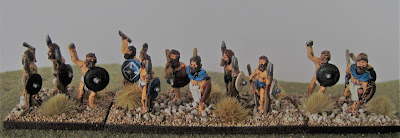There are of course Berbers and Berbers. I’m thinking of Berbers in Spain. Of course, Berbers are and were Berber, with Berber military traditions. A quick look at Moorish and Numidian forces in ancient days shows the roots of that tradition. Broadly speaking I’m going to end up with a list of units rather than a specific army list.
This is my thinking so far.
When the ground was right, restrictive to cavalry and close formation troops, massed Berber skirmishers could attack in waves hurling javelins at close range. On one such occasion they lured veteran Arab cavalry into dismounting to pursue them into difficult ground. The Berbers then attacked destroying the Arab force.
On open ground other tactics were required and found. These revolved around the veiled spear men you see above.
Some tribes enjoyed a better military reputation than others. Unfair? Maybe. It does allow us to vary the rating of units. For example, we might have:
Veteran Berber spear men or Levy Berber spear men. The veterans might be Retinue in Billhooks terms.
Berber spear men might also be in a block with a second rank of archers. The archers might be levy or might not. A third rank of cavalry stood behind the archers. Importantly, the cavalry could advance directly through both lines of infantry when the time came for a counter attack.
Sub Saharan troops loom large in Berber Armies.
They might be mercenaries and so retinue. Or, military slaves and so possibly not.
They could be spear men or archers or a highly rated Black Guard unit. I've just ordered a unit of the latter because...El Cid.
Berber skirmishers were very good. Fortunately, Billhooks already provides for
such fellows. I’ll use the Kern stat’s. Often
such Berber infantry formed a second line behind the spear men and threw javelins
over their heads. The spear men leveled
their spears, butts firmly grounded and knelt behind their shields to facilitate that. This means we should allow our Berber
skirmishers to form up to carry out that function.
That leads us nicely to Berber tactics in set piece battle. The light cavalry deployed on the wings or in front of the army. The light infantry was on the flanks. The centre was formed of spear men with supporting archers or javelin throwers. Behind this more cavalry waited.
The idea was to absorb the enemy charge and counter charge when they were disordered. On occasion this was combined with a flank attack.
If you are interested in the Crusades, you might now be
thinking “Just like the Fatimid’s battle tactics.” A moment later you might add "and Frankish tactics in Outremer".
This raises the interesting question were all Berber cavalry light skirmishers? I don’t know the answer. I can say that Berber cavalry in Fatimid armies did not skirmish but fought hand to hand.
Here is another thing, Berber armies could manoeuvre in response to drum signals. I think that calls for a special card. My take is simple, the card will allow the whole army to advance or retire a single move. It can be played once in a game.
That’s it so far. More soon.











Lovely units. I enjoyed reading your comments about their tactics. Very interesting.
ReplyDeleteThanks Richard. They were/are great survivors. They saw out the Carthaginians, the Romans, the Vandals, the Arabs too. Quite an achievement.
DeleteAnd what luvvly Berbers they are too!
ReplyDeleteCheers Ray and Happy New Year. They're nice and lively.
ReplyDelete